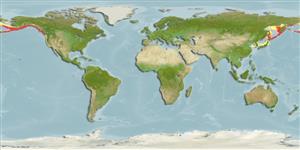>
Perciformes/Zoarcoidei (Eelpouts and pricklebacks) >
Zaproridae (Prowfish)
Etymology: silenus: Named after Silenus, a drunkard demigod who fell in a marsh on a revel and became covered with slime (Ref. 6885).
Eponymy: Silenus, in Greek mythology, was a companion and tutor to the wine-god Dionysus. He was usually drunk, and the binomial may have been inspired by the fact that the holotype was preserved in alcohol. (Ref. 128868), visit book page.
More on author: Jordan.
Environment: milieu / climate zone / depth range / distribution range
Ecologia
marinhas demersal; intervalo de profundidade 0 - 675 m (Ref. 50550), usually 0 - 500 m (Ref. 28981). Boreal; 0°C - 4°C (Ref. 56462); 66°N - 34°N
North Pacific: Hokkaido, Japan and western Kamchatka, Russia to Navarin Canyon in the Bering Sea, Attu Island in the Aleutian chain and San Miguel Island, California, USA.
Length at first maturity / Tamanho / Peso / Idade
Maturity: Lm 57.0 range ? - ? cm
Max length : 88.0 cm TL macho/indeterminado; (Ref. 2850); common length : 42.9 cm TL macho/indeterminado; (Ref. 56462); peso máx. Publicado: 7.0 kg (Ref. 56462); Idade máx. registada: 9 anos (Ref. 56462)
Descrição breve
Chaves de identificação | Morfologia | Morfometria
Espinhos dorsais (total) : 54 - 57; Raios dorsais moles (total) : 0; Espinhos anais: 0; Raios anais moles: 29 - 30. Caudal rounded.
Adults occur near bottom (Ref. 2850). Young to 7.2 cm are pelagic or bathypelagic, usually associated with jellyfish (Ref. 6885). Juveniles take shelter under the medusae and are often mistaken for medusafish Icichthys lockingtoni (Ref. 50276).
Life cycle and mating behavior
Maturidade | Reprodução | Desova | Ovos | Fecundidade | Larvas
Eschmeyer, W.N., E.S. Herald and H. Hammann, 1983. A field guide to Pacific coast fishes of North America. Boston (MA, USA): Houghton Mifflin Company. xii+336 p. (Ref. 2850)
Categoria na Lista Vermelha da IUCN (Ref. 130435: Version 2024-2)
Ameaça para o homem
Harmless
Utilização humana
Pescarias: pescarias de subsistência
Ferramentas
Relatórios especiais
Descarregue XML
Fontes da internet
Estimates based on models
Preferred temperature (Ref.
123201): 1.4 - 8.9, mean 4.7 °C (based on 1470 cells).
Phylogenetic diversity index (Ref.
82804): PD
50 = 1.5000 [Uniqueness, from 0.5 = low to 2.0 = high].
Bayesian length-weight: a=0.01738 (0.00677 - 0.04463), b=2.97 (2.75 - 3.19), in cm total length, based on LWR estimates for this (Sub)family-body shape (Ref.
93245).
Nível Trófico (Ref.
69278): 3.7 ±0.1 se; based on diet studies.
Generation time: 6.1 ( na - na) years. Estimated as median ln(3)/K based on 1
growth studies.
Resiliência (Ref.
120179): Baixo, tempo mínimo de duplicação da população 4,5 - 14 anos (tm= 5.1; K= 0.18).
Fishing Vulnerability (Ref.
59153): Moderate to high vulnerability (54 of 100).
Nutrients (Ref.
124155): Calcium = 17.6 [9.1, 33.0] mg/100g; Iron = 0.374 [0.139, 0.762] mg/100g; Protein = 15.8 [12.9, 19.4] %; Omega3 = 0.282 [0.150, 0.532] g/100g; Selenium = 22 [9, 54] μg/100g; VitaminA = 4.75 [0.88, 24.05] μg/100g; Zinc = 0.289 [0.193, 0.435] mg/100g (wet weight); based on
nutrient studies.
